
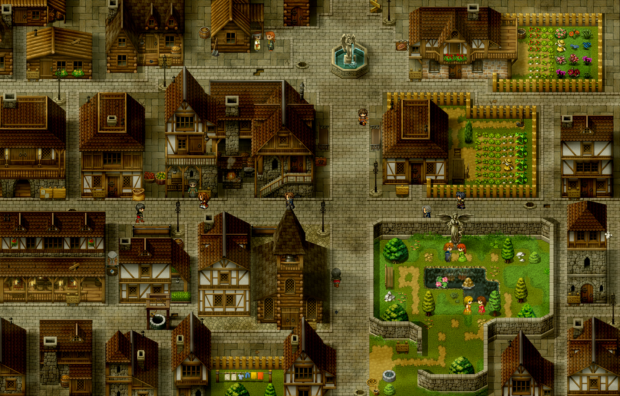 Review Fix chats with Olivier Larrieu, designer of Bleeding Moons and founder of IAN Games who lets us know why the game, inspired by the indie classic, “T the Moon,†is a special adventure worth experiencing.
Review Fix chats with Olivier Larrieu, designer of Bleeding Moons and founder of IAN Games who lets us know why the game, inspired by the indie classic, “T the Moon,†is a special adventure worth experiencing.
Review Fix: How was this game born?
Olivier Larrieu: Long story coming!
These past years, indie games have become more and more present in the video gaming world. One engine was frequently coming up as a common factor: Unity. So, one day, I decided to try it. I had a few ideas for games, mainly adventure games, but I quickly faced a major issue: I cannot do 3D models. As much as finding free, quality 2D textures were easy, finding good looking 3D models that were suitable for my games and affordable was a challenge.
I then decided to look at the problem another way. What engine has enough resources and/or can I add to it easily?
The success of To the Moon put me on track: RPG Maker. Although that game had been done with this engine, it is more like an adventure game with well-thought out characters and a strong story.
The kind of game I wanted to make.
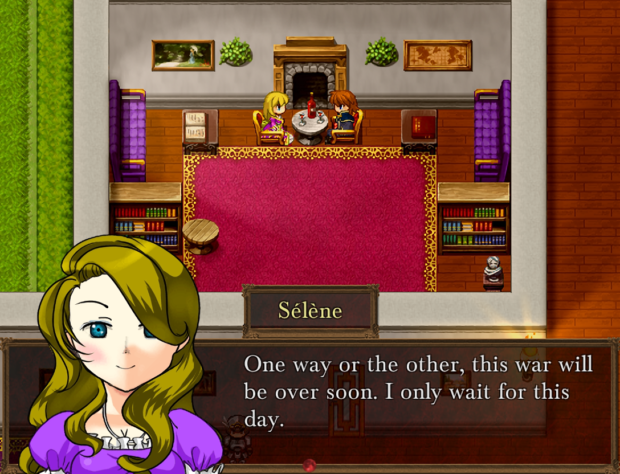
Starting from scratch, I bought RPG Maker VX Ace and went looking for useful resources, either directly or as inspiration so that I could create a game with no limitation on that side.
From these elements, Bleeding Moons was born.
At first, it was titled “No Hero Here.” I didn’t want to make a game with an invincible hero, full of virtue to the brim. I wanted a common man, facing events way above him. In the end, he realized that all he did was just surviving. He had been engulfed in a war and wouldn’t come out unscathed.
The Moons part came naturally, once I realized that my characters River Moon (a nod to To the Moon) and Luna had both names related to the moon. I then decided to name the third main female character, Sélène.
What about Bleeding? Because all three of them are tormented in their lives.
River seems to have a peaceful life. She’s pretty and likes her work. But she’s lonely. She barely sees her father the baker, who’s resting when she manages the shop. Her mother died and she misses her terribly. She would have liked to have a little brother, but that’ll never happen. With the workload she has, River doesn’t have the time to make friends. Ian is the only one she deeply cares about. She loves him and can’t prevent herself from seeing him as her beacon to change her fate. And to be able to truly live, at last.
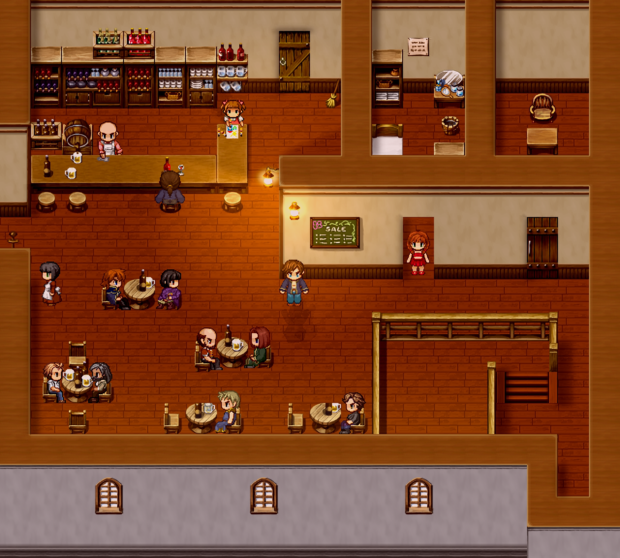 Luna is tormented by her tragic past. Her childhood is gone too soon. Nothing will ever be the same. That’s what made her become a soldier in the shadows, an assassin. Each one of her victims acts as a catharsis. Deep inside her, she believes in her redemption, one day. Ian is the one who can bring it to her.
Luna is tormented by her tragic past. Her childhood is gone too soon. Nothing will ever be the same. That’s what made her become a soldier in the shadows, an assassin. Each one of her victims acts as a catharsis. Deep inside her, she believes in her redemption, one day. Ian is the one who can bring it to her.
Sélène, at last, she is the little duchess. One could believe her happy and envy her destiny. But she too is alone. She has no friends in the castle, only servants. Her older brother had passed away, it’s to her that the burden of wearing the crown will fall after her father. Her mother is no longer able to rule and voluntarily exiled herself far from the people and the court. Protocol and a strict education to prepare her weigh heavily on her. She didn’t ask for all this. She just wants to laugh heartily, one day.
And, of course, Bleeding Moons is a reference to the activity of Ian. When he goes on a mission, at night, to assassinate an enemy dignitary behind the lines. Ian, too, is not spared by life. He dreamed of marrying River, but his father imposes an arranged marriage. He wanted to keep on reading books; he’ll be sent to the front line of the coming war. And when he believes that he’s acting for good and justice, he, too, will realize that he’s bleeding.
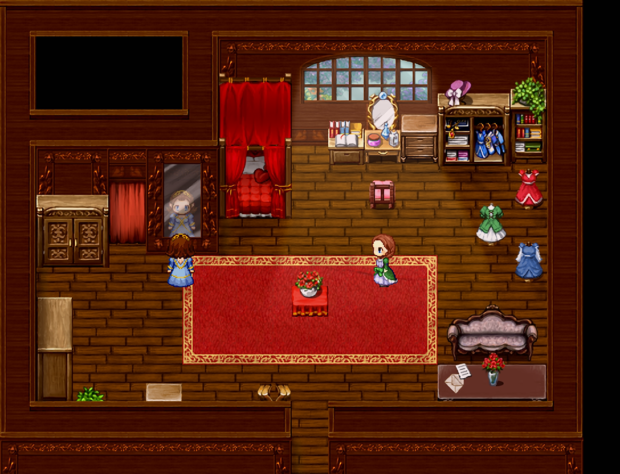
Review Fix: What has development been like so far?
Larrieu: I worked on Bleeding Moons in my spare time and holidays, doing everything alone. Of course, I didn’t program the engine. The graphics were, for a large part, already done by other people. But I still had a lot of work in term of editing, adapting, improving them. Same thing for the sound part of the programming.
And, of course, putting everything together to make a game with all that.
It’s a several thousand hours works over the span of two years, more or less. There have been a couple more years afterward, waiting for key illustration to be done and polishing the game from time to time. At some point, you have to stop working on a game because you’ll always find things to improve and never actually release it.
During these years of developing the game, I have learned such a vast quantity of things that I would have never believed I could learn when I started; whether it was on the general aspects of game making, its mechanics, or its components. I learned how to draw graphical elements myself that I needed but weren’t available, when I hadn’t touched any drawing software for more than 25 years. Likewise, I have learned how to manipulate sounds and music. I also learned how to use the game engine RPG Maker VX Ace, of which I knew nothing when I started working on Bleeding Moons.
 You no longer see a video game with the same eyes when you have a small idea of all the work that went into each and everything. Now, when I see a sprite animated to show an action, I no longer think to myself “Yes, it’s normal to see him do that.” I tell myself that there was someone behind that animation, who drew each pixel, sometimes for this sole sequence.
You no longer see a video game with the same eyes when you have a small idea of all the work that went into each and everything. Now, when I see a sprite animated to show an action, I no longer think to myself “Yes, it’s normal to see him do that.” I tell myself that there was someone behind that animation, who drew each pixel, sometimes for this sole sequence.
Review Fix: What makes this game special?
Larrieu: I don’t think there are a lot of games that are like Bleeding Moons, in that the emphasis on the story is very strong and yet, you have a lot of choices to shape it as you want.
Of course, you can’t do things that would drive the game to too divergent paths. I’m working alone on it, so it had to have some rails from which you can’t move too far.
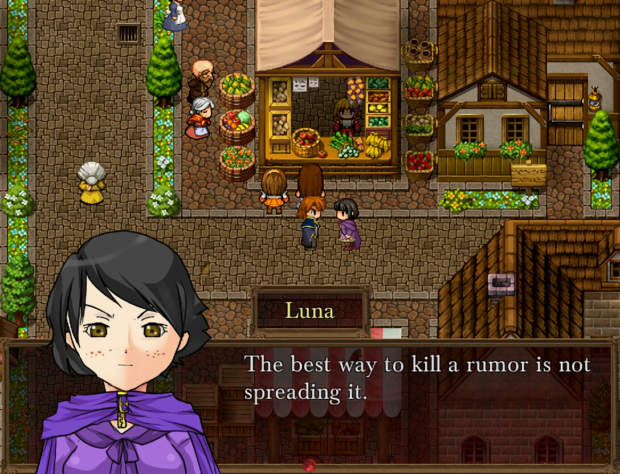
There is a sentence said by one of my characters that sum up my idea: “You can’t choose what life will bring you, but you can choose how you’ll face it.”
I send the players into a story, but they choose how they’ll react to it. Will they choose to kill or spare? Who will they romance? And so on.
The romance part is also unique in Bleeding Moons. Usually, once you settle for a love interest, it’s locked and that’s it. Here, you have several moments in the story where you can break up with someone, lie to another, sleep with one and marry another in the end. There are a lot of combinations, just like you’d expect in a real-life romance. And, of course, there are consequences. Some are tragic, and even a seemingly good ending can eventually turn very bad depending on what your past actions were.
Review Fix: How did “To the Moon” affect you?
Larrieu: It showed me that the kind of game I wanted to make was possible to do with limited resources and not too much skill required. If it weren’t for it, I wouldn’t have thought of using RPG Maker and would have ended my try with a failed Unity attempt. It is true to say that Bleeding Moons would have never been born without Kan Gao’s game.
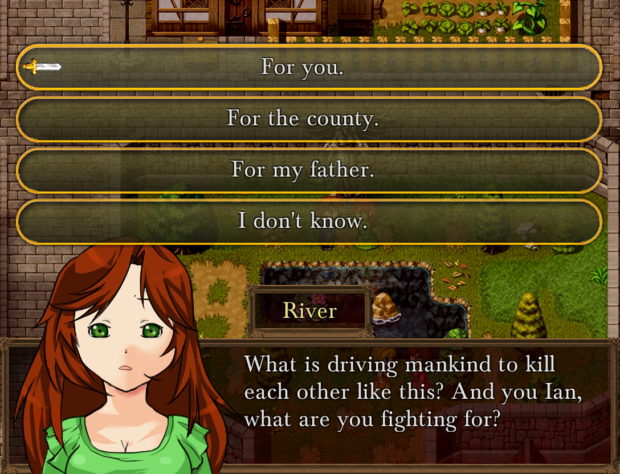 However, that doesn’t mean that I find To the Moon to be perfect. Even its maker admit it isn’t. So, I decided that my game would go beyond To the Moon wherever it could. I remember being frustrated that I couldn’t interact more with the world. Everything looked real, but you couldn’t interact with a lot of it. I kept wondering, why can’t I look at this picture? Why can’t I talk to these people? That’s why you can interact with almost everything in Bleeding Moons, decor and characters alike.
However, that doesn’t mean that I find To the Moon to be perfect. Even its maker admit it isn’t. So, I decided that my game would go beyond To the Moon wherever it could. I remember being frustrated that I couldn’t interact more with the world. Everything looked real, but you couldn’t interact with a lot of it. I kept wondering, why can’t I look at this picture? Why can’t I talk to these people? That’s why you can interact with almost everything in Bleeding Moons, decor and characters alike.
Each talking character has their own portrait with several emotions to make them more alive and believable. Life is an important part of the world of Bleeding Moons. Ian sees everyone as actual, living people, not just some random filler characters.
In that regard, To the Moon served as a mentor that I wanted to surpass, not making a clone of it.
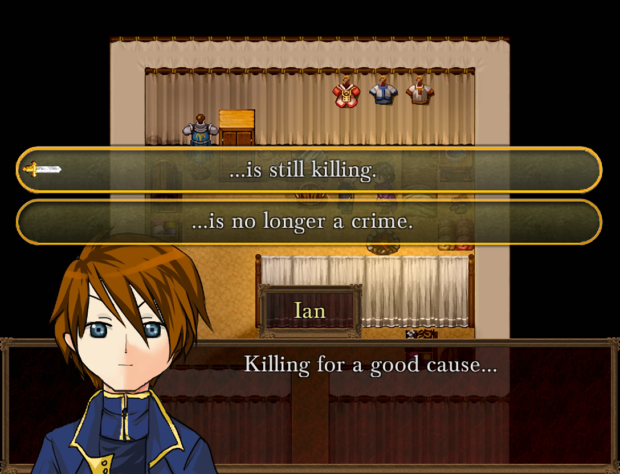
Review Fix: Why should we care about Ian de Valmain?
Larrieu: Ian has been written mostly based on me. That’s not to say that you should care about me, but that means that he’s a real person, with real reactions. I’ve written the story and Ian’s reactions as if I were the character. Again, I didn’t want to create a Hollywood hero. And the feedback I received from my beta testers was that they deeply connected with Ian since he has lifelike reactions like they would have had in his shoes. I think that having a relatable main character is an important part of a story.
There is an optional scene, far into the game. Ian can choose to go and see a prophetess in town, to have his future told. Instead of his future, the “prophetess” (who you would more call a psychologist nowadays) reveals nothing to Ian in regards to his fate, but she reassures him by reminding him of the importance of being alive, and what it changes for his loved ones. Ian is wrong in his definition of his life’s meaning after having read all those novels talking about extraordinary heroes. He never imagined it could be so simple, yet so important. He understands now that his life is not meant to save himself, but to save someone else: one of three women in his life who need him. One of the Bleeding Moons.


Leave a Reply